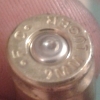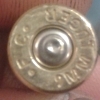

The picture looked a lot clearer before but can anyone tell if that looks like a pressure sign? both pictures are of the same primer. I loaded some 9mm 124 tcg bayou coated bullets with 4.0 grains of titegroup with an oal of 1.145 and didn't realize until after I had shot 34 of them that the bullets were hitting the rifling when chambered. They were fired out of a Taurus pt111 pro and maybe 1/3 of the primers looked like this, unfortunately I do not have any factory fired ammo to compare at this time. The primers are cci 500.



